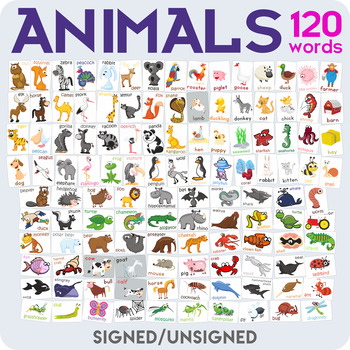Animals flashcards
- PDF
What educators are saying
Also included in
- This bundle includes:A big wonderful set of wild, sea and farm animals, insects and a little bit of other stuff for teaching and enlarging vocabulary. They are also perfect to drill various grammar patterns. Includes 120 words, signed and unsigned flashcards. More details.Two versions of Dobble (SpoPrice $3.95Original Price $4.40Save $0.45
Description
A big wonderful set of wild, sea and farm animals, insects and a little bit of other stuff for teaching and enlarging vocabulary. They are also perfect to drill various grammar patterns. Includes 120 words, signed and unsigned flashcards.
The set contains the following words:
Wild animals: parrot, lizard, squirrel, zebra, peacock, rabbit, deer, koala, snake, horse, camel, stork, giraffe, lemur, fox, elk, tiger, pelican, gorilla, donkey, racoon, ostrich, panda, kangaroo, seagull, owl, elephant, flamingo, frog, vulture, penguin, wolf, beaver, hedgehog, hog, lion, hippopotamus, bat, duck, skunk, turtle, chameleon, alligator, rhino, monkey, polar bear, bear, sloth, anteater, cheetah.
Farm: bull, cow, pig, rooster, goose, cat, calf, goat, horse, piglet, hen, dog, lamb, duckling, tractor, barn, hay, rabbit, duck, chick, sheep, donkey, farmer, mouse, puppy, kitten.
Sea life: dolphin, crab, squid, seal, moray, shark, whale, fish, hermit crab, walrus, goldfish, turtle, orca, stingray, lobster, clown fish, shell, hammerhead shark, narwhal, shrimp, sea urchin, penguin, seaweed, jellyfish, coral, starfish, seahorse, octopus.
Insects: grasshopper, mosquito, spider, butterfly, bug, slug, ladybird, caterpillar, ant, fly, dragonfly, mantis, worm, bee, snail, cockroach.
~~~~~~~~~~~~~~~~~~~~~~~~~~~~~~~~~~~
How to use:
- describe appearance and study body parts;
- learn adjectives and their degrees of comparison;
- create and tell different stories about animals and their life together with kids;
- add CLIL to your classes by representing some interesting and curious facts about animals, their habitat, food ration, way of living in wild nature and on the farm, the migrations of sea creatures in seas and oceans, about climate and currents, about a typical farmer's day and work, what everyday goods farm animals provide us with, agricultural equipment and lots of other things.
Besides, there is a great number of flashcard games which you can play with your students to make them learn the vocabulary easily in a fun and engaging way.
~~~~~~~~~~~~~~~~~~~~~~~~~~~~~~~~~~~
Flashcard games:
· Listen, point and say. Place flashcards or objects for the key vocabulary around the classroom. Call out a vocabulary word. The children point to the correct flashcard or object. Alternatively, play the chant with the target vocabulary and the children point or touch the correct card when they hear the word. Now point to the flashcards one by one, the children must say the words. Option: describe the location of the card, e.g. It's next to the window. What's this? The children then say the word.
· What's missing? Put a number of flashcards (6-8) on the table (or floor) face-up in order all the players could see them properly. Students look at the cards trying to memorize as many as possible. Ask them to close their eyes and remove one (or more cards). Ask: what's missing? They must name the missing card. The student who does it first, gets a point or has a go to take away another card. Option: to make the game harder, add a new card from a related lexical set each time or remove more than one card. To make the game more effective, and reduce teacher talking time, divide the students into groups and give them cards with vocabulary you want them to learn or revise.
· Memory game. Print two sets of flashcards. Put all cards face down on the floor (or table), determine the order of the players in the game. Children take turns to open two cards and name them. If they match, the player keeps the cards and has another go, if they don't the cards are turned over again and another child goes. At the end of the game you can ask children to make short sentences with target grammar and vocabulary using the cards they have won.
· Kim's game. Choose several cards, children look at them very attentively and try to memorize. Then the cards are covered with a towel and they have to name as many cards as possible.
· Fortress. Draw a fortress on the board. Tell children that it is attacked by enemies, add a ladder to the wall without some steps (5-7). The goal is to defend the fortress. Show the cards, children must say the correct words. 1 mistake – add 1 missing step on the ladder. If they are mistaken less than the number of missing steps, the fortress is saved!
· Describe and guess. A student gets a card and starts to describe it without showing to other participants of the game. (e.g. It's a small green animal, it can jump.) Others try to guess the word, asking questions: Is it a frog? Yes, it is. Variation: to make the game more challenging, give students slips of paper with words they are banned from mentioning (e.g. for hot-air balloon: hot, air, sky).
Read more games in the PREVIEW file
❗ Print on cardstock and laminate for a durable use.
~~~~~~~~~~~~~~~~~~~~~~~~~~~~~~~~~~~~
⭐ You may also be interested in:
► What do you know about? Board Game
► Speaking cards (have got/has got; like/likes)
► Possessives Worksheets 3in1
~~~~~~~~~~~~~~~~~~~~~~~~~~~~~~~~~~~~~
⚡ Also, you can earn TPT credits to use on future purchases!
You can give a rating and leave a comment for each product you bought or downloaded for free in our shop. Each time you give feedback, TPT gives you feedback credits that you use to lower the cost of your future purchases.
Moreover, your feedbacks help us improve the resources we create to fit the needs of EFL teachers all over the world.
♥ Follow us to see our newest stuff and printables in action: TELEGRAM, FACEBOOK, INSTAGRAM, PINTEREST, VK





